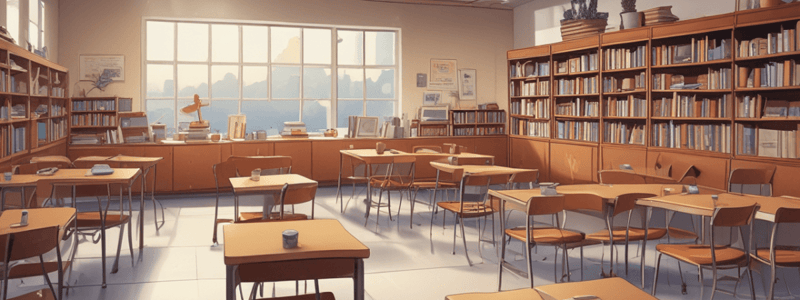Podcast
Questions and Answers
What is the primary goal of placing commonly used materials in multiple locations around the classroom?
What is the primary goal of placing commonly used materials in multiple locations around the classroom?
- To encourage students to work only in specific areas of the classroom
- To increase adult intervention in the classroom
- To restrict access to certain materials for some students
- To reduce congestion in popular areas of the classroom and encourage students to work anywhere (correct)
What is a valuable life skill that students develop in a well-organized classroom?
What is a valuable life skill that students develop in a well-organized classroom?
- Dependence on teachers for learning
- Taking responsibility for their own learning experience (correct)
- Avoiding classroom activities
- Following strict classroom rules
What is an outcome of implementing organizational strategies in the classroom?
What is an outcome of implementing organizational strategies in the classroom?
- Increased chaos and reduced productivity
- A classroom environment that fosters independence and learning (correct)
- Fewer teaching and learning activities
- More time spent on classroom management
Why are materials placed in multiple locations around the classroom?
Why are materials placed in multiple locations around the classroom?
What happens when there are bottlenecks at single storage points in the classroom?
What happens when there are bottlenecks at single storage points in the classroom?
What is a benefit of a well-organized classroom?
What is a benefit of a well-organized classroom?
What is the purpose of implementing organizational strategies in the classroom?
What is the purpose of implementing organizational strategies in the classroom?
What is a result of students having autonomy in the classroom?
What is a result of students having autonomy in the classroom?
Why is it beneficial to have multiple storage points in the classroom?
Why is it beneficial to have multiple storage points in the classroom?
What is a key aspect of a well-organized classroom?
What is a key aspect of a well-organized classroom?
Flashcards are hidden until you start studying
Study Notes
Organizing the Classroom Environment
- A well-organized classroom environment is crucial for young children's learning and development.
- The environment should be designed to facilitate learning, exploration, and independence.
Interest Areas
- 10 common interest areas recommended for preschoolers:
- Block areas
- Dramatic play areas
- Toy and game areas
- Art areas
- Library areas
- Discovery areas
- Sand and water areas
- Music and movement areas
- Cooking areas
- Computer areas
- Each interest area should be designed to promote learning, exploration, and socialization.
Block Areas
- Should include various materials to spark curiosity and exploration, such as large and small blocks, wooden, cardboard, foam, or interlocking blocks.
- Accessories like toy figures, cars, and construction equipment can be included.
Dramatic Play Areas
- Allow children to take on roles and try out new ideas, and practice self-care skills.
- Props like dress-up clothes, kitchen tables, clothes, food, and dolls can be provided.
Toy and Game Areas
- Include a range of puzzles, board games, and small objects to develop thinking skills, social skills, and fine motor skills.
- Allow children to identify and match colors, shapes, sizes, and textures.
Art Areas
- Provide a variety of materials for children to use and explore, such as sponges, rollers, glitter, tape, paint, stamps, and recycled materials.
- Can feature displays of famous artwork, books, and children's creations.
Library Areas
- A quiet space where children can relax and enjoy reading.
- Include a variety of books, fiction, non-fiction, alphabet books, number books, nursery rhymes, magazines, and resource books.
- Soft furniture or pillows, books displayed on shelves or in baskets, and a listening station can be provided.
Discovery Areas
- Contain materials for open-ended exploration, such as natural materials, rocks, pinecones, shells, and tools for exploration like microscopes, magnifying glasses, and balances.
- Provide opportunities for experiments, caring for a class pet, and scientific exploration.
Sand and Water Areas
- Allow children to engage in measuring, pouring, comparing, and creating activities.
- Can include a variety of materials like leaves, snow, packing peanuts, shredded paper, and other sensory materials.
Music and Movement Areas
- Provide opportunities for children to make their own music and respond to the music of others.
- Include materials like streamers, ribbons, shakers, musical instruments, and recorded music.
Cooking Areas
- Allow children to practice real-life skills and introduce a variety of cultures to the classroom.
- Can be a flexible part of the room, perhaps at a table children typically use to eat snacks.
Computer Areas
- Provide developmentally appropriate learning opportunities for children of various ages.
- Can expose children to people, animals, activities, and places they cannot experience in person.
Creating a Homelike Environment
- Incorporate elements typically found in a home, such as soft furnishings, non-toxic plants, and soft natural lighting.
- Display family photos, children's artwork, and personal touches to make the environment feel special and reassuring.
Fostering Independence
- Make sure children can easily access materials on their own by storing them on low, open shelves.
- Use labels and signs to help children recognize and use symbols in their environment.
- Involve children in creating labels to enhance their literacy skills and sense of ownership.
Engaging and Inclusive Classroom Environment
- Display materials at children's eye level to capture their attention and encourage engagement.
- Incorporate books, toys, art supplies, and other materials that showcase a range of cultures, languages, and experiences.
- Rotate classroom materials regularly to maintain a fresh and stimulating environment.
Organizing Classroom Materials
- Group similar items together to simplify the process of locating and using them.
- Use open bins and shelves that allow children to see and access contents easily.
- Place commonly used materials in multiple strategic locations around the classroom.
Studying That Suits You
Use AI to generate personalized quizzes and flashcards to suit your learning preferences.




